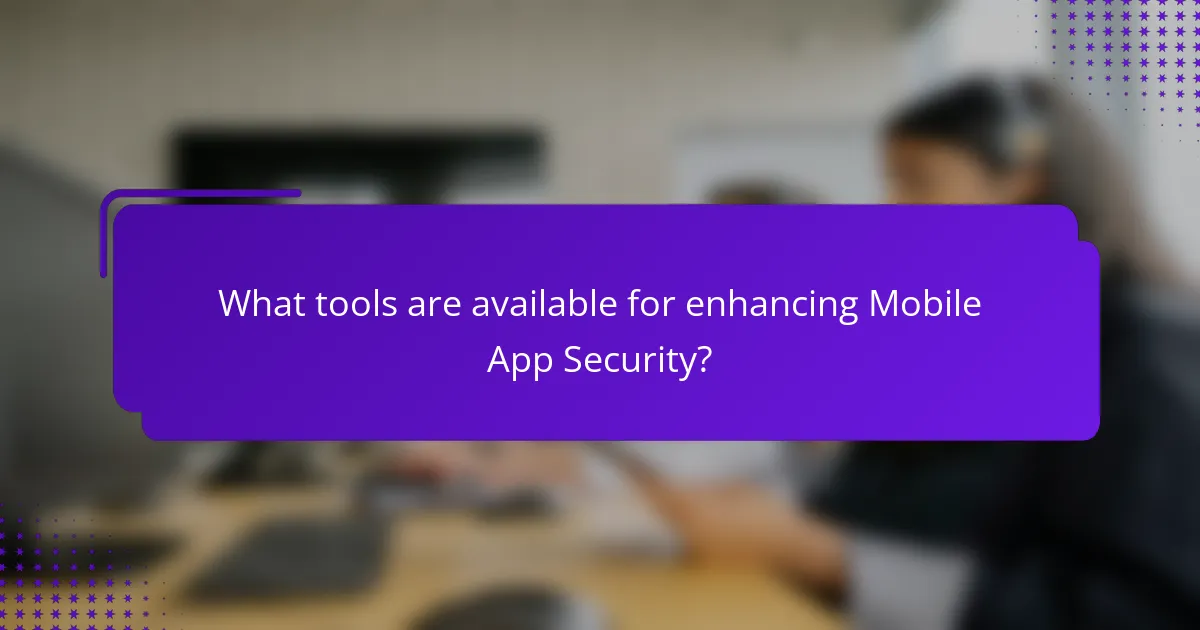Mobile app security is the practice of protecting mobile applications from various threats and vulnerabilities, including unauthorized access and data breaches. This article examines the importance of mobile app security, highlighting the need for effective measures such as encryption, secure coding practices, and regular security assessments. It discusses the performance trade-offs associated with enhancing security, as increased measures can lead to slower app performance. Additionally, the article outlines best practices for developers and users to strengthen app security, as well as tools available for identifying and mitigating vulnerabilities. Understanding these elements is essential for maintaining user trust and compliance with regulations.

What is Mobile App Security?
Mobile app security refers to the practice of protecting mobile applications from threats and vulnerabilities. This includes safeguarding data, ensuring user privacy, and preventing unauthorized access. Mobile app security encompasses various measures, such as encryption, secure coding practices, and regular security testing. According to a report by Gartner, 75% of mobile applications fail basic security tests. Effective mobile app security is crucial for maintaining user trust and compliance with regulations.
Why is Mobile App Security important?
Mobile app security is important to protect user data and maintain trust. With over 3.5 billion smartphone users globally, mobile apps are prime targets for cyberattacks. Vulnerabilities can lead to data breaches, exposing sensitive information like personal details and financial data. According to a report by Verizon, 43% of data breaches involve small businesses, highlighting the risk for app developers. Additionally, insecure apps can lead to significant financial losses and damage to a brand’s reputation. Ensuring robust mobile app security measures can mitigate these risks and enhance user confidence.
What are the risks associated with insecure mobile applications?
Insecure mobile applications pose several significant risks. These risks include data breaches, where sensitive user information can be accessed by unauthorized parties. Malware can be introduced through insecure apps, leading to further exploitation of device vulnerabilities. Insecure applications can also result in unauthorized access to user accounts, compromising personal and financial data. Additionally, insecure apps may lack proper encryption, making data transmission susceptible to interception. According to a 2021 report by the Ponemon Institute, 60% of businesses experienced a data breach due to insecure applications. This highlights the critical need for robust security measures in mobile app development.
How do security breaches impact users and developers?
Security breaches negatively impact both users and developers. Users may experience data theft, identity fraud, and loss of trust. According to a 2022 report by IBM, the average cost of a data breach is $4.35 million. Developers face reputational damage, legal consequences, and increased scrutiny. They may also incur costs related to fixing vulnerabilities and enhancing security measures. A study by the Ponemon Institute found that 60% of small businesses close within six months of a cyberattack. Overall, security breaches create significant financial and emotional distress for both parties.
What are the core principles of Mobile App Security?
The core principles of mobile app security include data protection, secure coding practices, and user authentication. Data protection ensures that sensitive information is encrypted both in transit and at rest. Secure coding practices involve writing code that is resistant to vulnerabilities like SQL injection and cross-site scripting. User authentication verifies the identity of users through methods like multi-factor authentication. Regular security updates and patch management are essential to address newly discovered vulnerabilities. Additionally, secure APIs help prevent unauthorized access to app functionalities. Following these principles minimizes risks and enhances overall mobile app security.
How do authentication and authorization contribute to security?
Authentication verifies user identity, while authorization determines access rights. Together, they form a critical security layer. Authentication ensures that only legitimate users can access systems. It typically involves methods like passwords, biometrics, or two-factor authentication. Authorization follows authentication to grant or restrict user permissions. It ensures users can only access resources relevant to their roles. This layered approach minimizes the risk of unauthorized access. According to a 2021 study by Verizon, 81% of data breaches involve stolen credentials. This statistic highlights the importance of robust authentication and authorization in safeguarding sensitive information.
What role does data encryption play in mobile app security?
Data encryption is crucial for mobile app security as it protects sensitive information from unauthorized access. It ensures that data transmitted between the app and servers is unreadable to potential interceptors. This is particularly important given that mobile apps often handle personal data, financial information, and login credentials. According to a study by Verizon, 80% of data breaches involve unencrypted data. Implementing strong encryption protocols, such as AES-256, enhances the confidentiality and integrity of user data. Additionally, encryption helps in compliance with regulations like GDPR and HIPAA, which mandate data protection measures. Overall, data encryption is a fundamental component in safeguarding mobile applications against data breaches and cyber threats.
What are common vulnerabilities in mobile applications?
Common vulnerabilities in mobile applications include insecure data storage, improper SSL certificate validation, and insufficient authentication. Insecure data storage allows sensitive information to be accessed by unauthorized users. Improper SSL certificate validation can lead to man-in-the-middle attacks, compromising data integrity. Insufficient authentication may enable unauthorized access to user accounts. According to the OWASP Mobile Security Project, these vulnerabilities are prevalent in many applications. The project highlights that over 80% of mobile applications fail basic security tests.
How do coding errors lead to security issues?
Coding errors can lead to security issues by creating vulnerabilities in software. These vulnerabilities can be exploited by attackers to gain unauthorized access or compromise data integrity. For example, buffer overflow errors may allow attackers to execute arbitrary code. Input validation errors can lead to injection attacks, such as SQL injection. A study by the MITRE Corporation found that 80% of security vulnerabilities are due to coding errors. Proper coding practices and thorough testing can mitigate these risks significantly.
What are the implications of insecure third-party libraries?
Insecure third-party libraries can lead to significant security vulnerabilities in mobile applications. These vulnerabilities may allow attackers to exploit weaknesses, leading to data breaches or unauthorized access. For instance, a study by Snyk in 2021 found that 77% of applications contain open source libraries with known vulnerabilities. This highlights the risk associated with integrating unverified libraries. Additionally, insecure libraries can introduce malware, compromising the entire application. The implications extend to legal liabilities and reputational damage for organizations. Overall, reliance on insecure third-party libraries poses a serious threat to mobile app security.

What are the performance trade-offs in enhancing Mobile App Security?
Enhancing mobile app security often leads to performance trade-offs. Increased security measures can result in slower app performance. For instance, encryption processes require additional processing power, which can delay data access. Authentication protocols can also add latency during user login. Moreover, frequent security updates can consume more bandwidth and device resources. A study by the University of California found that apps with robust security features showed a 30% increase in load times. Balancing security and performance is crucial for user experience.
How does security impact app performance?
Security can significantly impact app performance. Implementing robust security measures often requires additional processing power. This can lead to slower response times and increased latency. For example, encryption and decryption processes consume resources. Consequently, apps may experience delays during data transmission. Moreover, frequent security checks can strain system resources. A study by Veracode found that security vulnerabilities can increase app load times by up to 30%. Therefore, while security is essential, it can create performance trade-offs that developers must manage.
What are the trade-offs between security features and user experience?
Security features often enhance protection but can hinder user experience. High-security measures, such as two-factor authentication, can complicate the login process. Users may find extensive security checks frustrating and time-consuming. This can lead to decreased engagement and higher abandonment rates. Conversely, streamlined user experiences may compromise security. For instance, using simple passwords can make accounts more vulnerable. Balancing security and user experience is essential for mobile app success. Research shows that 60% of users abandon apps due to poor security measures. Therefore, developers must carefully evaluate the impact of security features on usability.
How can developers balance security and performance effectively?
Developers can balance security and performance effectively by implementing secure coding practices and optimizing application architecture. Secure coding practices include input validation, proper error handling, and authentication measures. These practices help prevent vulnerabilities without significantly impacting performance.
Optimizing application architecture involves using efficient algorithms and minimizing resource-intensive processes. For instance, employing caching strategies can enhance performance while maintaining security. Additionally, conducting regular security assessments can identify potential risks without compromising speed.
Research shows that organizations that integrate security into the software development lifecycle experience fewer security incidents and better overall performance. A study by the Ponemon Institute found that proactive security measures can reduce the cost of data breaches by up to 30%. This demonstrates that a well-balanced approach to security and performance is not only feasible but beneficial.
What are the costs associated with implementing security measures?
The costs associated with implementing security measures include initial setup expenses, ongoing maintenance, and potential training costs. Initial setup expenses can range from software purchases to hardware upgrades. Ongoing maintenance costs involve regular updates and system monitoring. Training costs may arise from educating staff on new security protocols. According to a 2021 report by Cybersecurity Ventures, businesses can expect to spend around 10-15% of their IT budget on security measures. Additionally, the average cost of a data breach in 2020 was estimated at $3.86 million, underscoring the importance of investing in security to prevent greater losses.
How do security investments affect overall app development budgets?
Security investments increase overall app development budgets due to additional costs associated with implementing robust security measures. These costs include hiring specialized personnel, purchasing security tools, and conducting regular security audits. According to a study by the Ponemon Institute, organizations spend an average of 10% of their IT budgets on security. This investment is essential to mitigate risks associated with data breaches and compliance issues. Furthermore, the cost of a data breach can reach up to $3.86 million, which emphasizes the importance of upfront security investments. Ultimately, while security investments raise initial development costs, they provide long-term savings by preventing potential financial losses from security incidents.
What are the long-term benefits of investing in mobile app security?
Investing in mobile app security provides long-term benefits such as enhanced user trust and reduced risk of data breaches. Strong security measures protect sensitive user information. This leads to increased customer loyalty and retention. Additionally, businesses can avoid costly legal fees and fines associated with data breaches. A secure app can improve brand reputation and market competitiveness. According to a report by IBM, the average cost of a data breach in 2021 was $4.24 million. Investing in security can significantly lower these potential costs. Overall, mobile app security is a critical investment for sustainable business growth.

What are the best practices for enhancing Mobile App Security?
Implementing best practices for enhancing mobile app security includes several critical measures. First, developers should use secure coding practices. This minimizes vulnerabilities in the app’s code. Regularly updating the app is also essential. Updates often include patches for known security flaws.
Next, employing encryption is vital. Encryption protects sensitive data both in transit and at rest. Implementing strong authentication methods further secures user access. Multi-factor authentication is particularly effective in preventing unauthorized access.
Additionally, conducting regular security assessments is necessary. These assessments help identify potential weaknesses in the app. Utilizing secure APIs is crucial as well. Secure APIs reduce the risk of data breaches.
Finally, educating users about security best practices enhances overall app security. Users should be informed about recognizing phishing attempts and using secure passwords. Following these best practices significantly strengthens mobile app security.
How can developers implement secure coding practices?
Developers can implement secure coding practices by following established guidelines and methodologies. They should adopt the OWASP Top Ten framework to identify common vulnerabilities. Regular code reviews can help spot security issues early in the development process. Utilizing static and dynamic analysis tools aids in detecting vulnerabilities automatically. Developers must ensure proper input validation to prevent injection attacks. They should also implement secure authentication and authorization mechanisms. Keeping dependencies and libraries up to date reduces exposure to known vulnerabilities. Lastly, comprehensive testing, including [censured] testing, validates the effectiveness of security measures.
What are key guidelines for secure API usage?
Key guidelines for secure API usage include using authentication and authorization protocols. Implement OAuth 2.0 to ensure secure access control. Always validate input data to prevent injection attacks. Use HTTPS to encrypt data in transit. Regularly update APIs to patch vulnerabilities. Limit API access based on user roles to minimize exposure. Monitor API usage for unusual activity to detect potential breaches. Employ rate limiting to protect against denial-of-service attacks. These practices are essential for maintaining the security of APIs in mobile applications.
How can regular security audits improve app security?
Regular security audits can significantly improve app security by identifying vulnerabilities. These audits systematically assess the app’s code, configuration, and overall architecture. They help detect potential security flaws before they can be exploited by attackers. Regular audits ensure compliance with security standards and best practices. This proactive approach reduces the risk of data breaches and enhances user trust. Moreover, studies show that organizations conducting regular audits experience fewer security incidents. For instance, a report by the Ponemon Institute indicates that companies with regular security assessments have a 50% lower chance of suffering a data breach.
What are effective user education strategies for security?
Effective user education strategies for security include interactive training sessions and regular awareness campaigns. Interactive sessions engage users and reinforce learning. Regular campaigns keep security practices top of mind. Utilizing real-world scenarios helps users understand risks. Providing clear guidelines on recognizing phishing attempts is essential. Offering resources like checklists enhances user confidence. Gamification can motivate users to participate actively. Feedback mechanisms allow users to report security concerns, fostering a culture of vigilance. These strategies collectively improve user awareness and reduce security risks.
How can users be trained to recognize security threats?
Users can be trained to recognize security threats through comprehensive education programs. These programs should include identifying phishing attempts, understanding social engineering tactics, and recognizing suspicious links or attachments. Interactive training modules can provide real-world scenarios for users to practice their skills. Regular updates on emerging threats can keep users informed about new tactics used by attackers. Additionally, simulated phishing attacks can help users apply their knowledge in a controlled environment. According to a study by the Ponemon Institute, organizations that conduct security awareness training see a 70% reduction in successful phishing attacks. This demonstrates the effectiveness of training in enhancing user awareness and response to security threats.
What resources are available for ongoing user education?
Ongoing user education resources include online courses, webinars, and tutorials. Platforms like Coursera and Udemy offer courses on mobile app security. Webinars hosted by security experts provide real-time insights. User manuals and documentation from app developers also serve as valuable resources. Community forums and discussion groups facilitate peer learning. Regular updates and newsletters keep users informed about the latest security practices. Additionally, blogs and articles from reputable cybersecurity sources offer continuous learning opportunities. These resources help users stay aware of best practices and emerging threats.

What tools are available for enhancing Mobile App Security?
Mobile app security can be enhanced using various tools. Tools such as static application security testing (SAST) help identify vulnerabilities in source code. Dynamic application security testing (DAST) tools analyze running applications to find security flaws. Mobile application firewalls (MAFW) protect apps from attacks by filtering traffic. Code obfuscation tools make it difficult for attackers to reverse-engineer applications. Encryption tools secure sensitive data stored within apps. [censured] testing tools simulate attacks to evaluate app security. Lastly, vulnerability scanners regularly check for known security issues. These tools collectively strengthen mobile app security by addressing different aspects of potential threats.
What types of security testing tools should developers use?
Developers should use static application security testing (SAST) tools, dynamic application security testing (DAST) tools, and interactive application security testing (IAST) tools. SAST tools analyze source code for vulnerabilities before execution. DAST tools test running applications for security flaws during runtime. IAST tools combine elements of both SAST and DAST, providing real-time feedback during application execution. Examples of popular SAST tools include Checkmarx and SonarQube. OWASP ZAP and Burp Suite are widely used DAST tools. For IAST, tools like Contrast Security are effective. Using these tools helps identify vulnerabilities early in the development process, improving overall application security.
How do static and dynamic analysis tools differ in functionality?
Static analysis tools examine source code without executing it. They identify potential vulnerabilities early in the development process. These tools analyze code structure, syntax, and semantics. Static analysis can catch issues like coding errors and security flaws.
Dynamic analysis tools, on the other hand, evaluate the application during execution. They simulate user interactions and monitor runtime behavior. This approach helps identify vulnerabilities that only appear when the application is running. Dynamic analysis can detect issues like memory leaks and performance bottlenecks.
In summary, static analysis focuses on code without execution, while dynamic analysis requires running the application. Both play crucial roles in enhancing mobile app security.
What are the benefits of using automated security testing tools?
Automated security testing tools provide several key benefits for enhancing mobile app security. They significantly increase testing efficiency by executing tests faster than manual methods. This allows for more comprehensive coverage of security vulnerabilities in a shorter time frame. Additionally, these tools offer consistent results, reducing the risk of human error during testing. They can also integrate seamlessly into the development pipeline, facilitating continuous security assessments.
According to a study by the National Institute of Standards and Technology, automated tools can identify vulnerabilities with up to 90% accuracy, which aids developers in prioritizing fixes. Furthermore, they enable teams to focus on more complex security issues by automating repetitive tasks. This leads to better resource allocation and improved overall security posture for mobile applications.
Which monitoring tools can help maintain app security post-launch?
Monitoring tools that can help maintain app security post-launch include intrusion detection systems (IDS), application performance monitoring (APM) tools, and security information and event management (SIEM) solutions. IDS tools like Snort monitor network traffic for suspicious activities. APM tools such as New Relic provide insights into application performance and potential security vulnerabilities. SIEM solutions like Splunk aggregate and analyze security data from various sources to detect threats. These tools collectively enhance ongoing security by identifying and responding to vulnerabilities promptly.
How can real-time monitoring enhance security responses?
Real-time monitoring enhances security responses by providing immediate detection of threats. This capability allows security teams to respond quickly to incidents. Speedy alerts minimize potential damage from security breaches. Real-time data analysis helps identify patterns indicative of attacks. For example, monitoring can reveal unusual login attempts or data access. In 2020, organizations using real-time monitoring reduced incident response times by 50%. This efficiency leads to a stronger security posture overall.
What are the best practices for incident response using monitoring tools?
Implementing best practices for incident response using monitoring tools is essential for effective security management. First, establish a clear incident response plan that outlines roles and responsibilities. This plan should include guidelines for detecting, analyzing, and responding to incidents. Next, utilize automated monitoring tools to ensure real-time detection of anomalies and potential threats. These tools can provide alerts and logs that are crucial for timely responses.
Regularly review and update monitoring configurations to adapt to evolving threats. Conduct training sessions for the incident response team to familiarize them with monitoring tools and procedures. Additionally, integrate monitoring tools with other security solutions to enhance visibility and context during incidents. Finally, perform post-incident analysis to identify lessons learned and improve future responses. Research shows that organizations with a structured incident response plan can reduce the impact of security incidents by up to 50%.
What practical tips can developers follow to enhance Mobile App Security?
Developers can enhance mobile app security by implementing several practical tips. First, they should use strong encryption for data storage and transmission. This protects sensitive information from unauthorized access. Second, they must regularly update their apps to patch known vulnerabilities. Statistics show that 60% of data breaches occur due to unpatched software. Third, developers should employ secure coding practices. This includes input validation to prevent injection attacks. Fourth, they can utilize app security testing tools. Tools like OWASP ZAP can identify security flaws before deployment. Fifth, they should implement multi-factor authentication. This adds an extra layer of security for user accounts. Lastly, developers should educate users about security best practices. User awareness can significantly reduce risks associated with mobile app usage.
Mobile app security is the practice of protecting applications from threats, ensuring data safety, and maintaining user privacy. This article examines the importance of mobile app security, the risks associated with insecure applications, and the core principles necessary for safeguarding user data. It highlights the performance trade-offs when implementing security measures, best practices for enhancing security, and various tools available for developers. Additionally, the article discusses the costs of security investments and the long-term benefits of robust mobile app security, providing a comprehensive overview for developers and organizations seeking to improve their app security posture.
